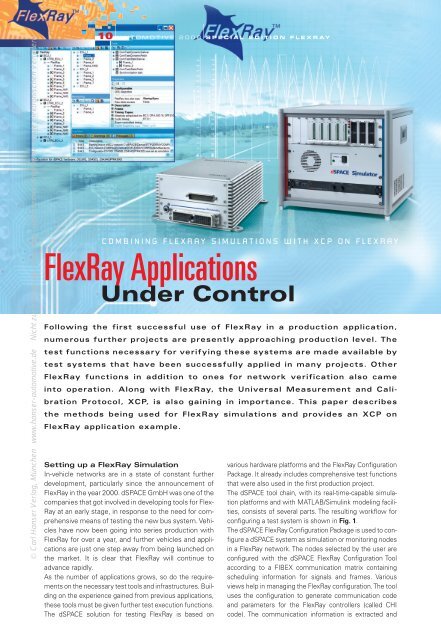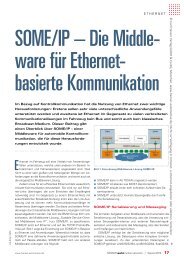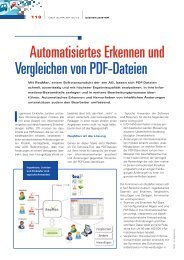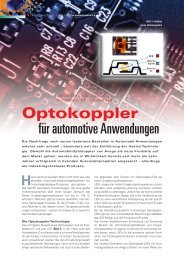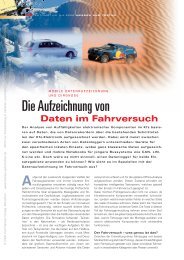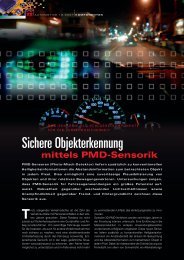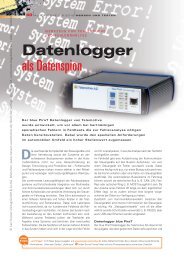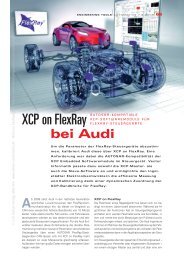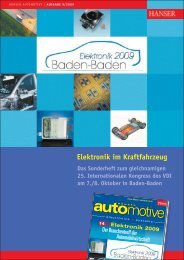Download - HANSER automotive
Download - HANSER automotive
Download - HANSER automotive
You also want an ePaper? Increase the reach of your titles
YUMPU automatically turns print PDFs into web optimized ePapers that Google loves.
© Carl Hanser Verlag, München www.hanser-<strong>automotive</strong>.de Nicht zur Verfügung im Intranet- und Internet-Angeboten sowie elektronischen Verteilern<br />
10lA UTOMOTIVE 2008l SPECIAL EDITION FLEXRAY<br />
COMBINING FLEXRAY SIMULATIONS WITH XCP ON FLEXRAY<br />
FlexRay Applications<br />
Under Control<br />
Following the first successful use of FlexRay in a production application,<br />
numerous further projects are presently approaching production level. The<br />
test functions necessary for verifying these systems are made available by<br />
test systems that have been successfully applied in many projects. Other<br />
FlexRay functions in addition to ones for network verification also came<br />
into operation. Along with FlexRay, the Universal Measurement and Calibration<br />
Protocol, XCP, is also gaining in importance. This paper describes<br />
the methods being used for FlexRay simulations and provides an XCP on<br />
FlexRay application example.<br />
Setting up a FlexRay Simulation<br />
In-vehicle networks are in a state of constant further<br />
development, particularly since the announcement of<br />
FlexRay in the year 2000. dSPACE GmbH was one of the<br />
companies that got involved in developing tools for Flex-<br />
Ray at an early stage, in response to the need for comprehensive<br />
means of testing the new bus system. Vehicles<br />
have now been going into series production with<br />
FlexRay for over a year, and further vehicles and applications<br />
are just one step away from being launched on<br />
the market. It is clear that FlexRay will continue to<br />
advance rapidly.<br />
As the number of applications grows, so do the requirements<br />
on the necessary test tools and infrastructures. Building<br />
on the experience gained from previous applications,<br />
these tools must be given further test execution functions.<br />
The dSPACE solution for testing FlexRay is based on<br />
various hardware platforms and the FlexRay Configuration<br />
Package. It already includes comprehensive test functions<br />
that were also used in the first production project.<br />
The dSPACE tool chain, with its real-time-capable simulation<br />
platforms and with MATLAB/Simulink modeling facilities,<br />
consists of several parts. The resulting workflow for<br />
configuring a test system is shown in Fig. 1.<br />
The dSPACE FlexRay Configuration Package is used to configure<br />
a dSPACE system as simulation or monitoring nodes<br />
in a FlexRay network. The nodes selected by the user are<br />
configured with the dSPACE FlexRay Configuration Tool<br />
according to a FIBEX communication matrix containing<br />
scheduling information for signals and frames. Various<br />
views help in managing the FlexRay configuration. The tool<br />
uses the configuration to generate communication code<br />
and parameters for the FlexRay controllers (called CHI<br />
code). The communication information is extracted and


